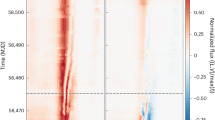Abstract
The discovery of the 1.81-MeV 26Al decay line in the present interstellar medium1 provided direct experimental proof that intermediate mass nuclei are being synthesized continuously in the Galaxy. The instruments making this and a subsequent observation2 had broad angular responses, thus, although both observations were consistent with a source near the centre of the Galaxy, interpretations for the origin of this radiation have included objects distributed throughout the Galaxy capable of synthesizing 26Al, such as type II supernova, Wolf Rayet stars, novae and red giants. New observations3 have localized this source to the galactic centre region consistent with a point source at the centre within the resolution function of the telescope (∼10° FWHM, full width at half maximum). Observations of the galactic 0.51-MeV positron annihilation line have also localized this line to the galactic centre with an angular resolution ∼15° FWHM4. Time variability requires that it come from a region ∼1 pc in size, hence it is probably produced near a compact object at or near the galactic centre5. Here we discuss the possibility that the 0.51- and 1.81-MeV lines have a common origin: the initial decay of 26Al to 26Mg with the most probable emission of a positron which eventually annihilates producing the 0.51-MeV line, followed by the decay of 26Mg to the ground state with the emission of the 1.81-MeV line. For this process to be solely responsible for both lines the time-integrated intensities of the lines must be compatible, and we show that this is not contradicted by the existing data. The measurement of the properties of the two lines individually and taken together place strong constraints on the source region of this radiation.
This is a preview of subscription content, access via your institution
Access options
Subscribe to this journal
Receive 51 print issues and online access
$199.00 per year
only $3.90 per issue
Buy this article
- Purchase on Springer Link
- Instant access to full article PDF
Prices may be subject to local taxes which are calculated during checkout
Similar content being viewed by others
References
Mahoney, W. A., Ling, J. C., Wheaton, W. A. & Jacobson, A. S. Astrophys. J. 286, 578–585 (1984).
Share, G. H. et al. Astrophys. J. 292, L61–L65 (1985).
von Ballmoos, P., Diehl, R. & Schönfelder, V. Astrophys. J. (submitted).
Leventhal, M., MacCallum, C. J. & Stang, P. D. Astrophys. J. L14 (1978).
Lingenfelter, R. E. & Ramaty, R. The Galactic Center, AIP Conf. Proc. 83, 148–159 (1982).
Riegler, G. R., Ling, J. C., Mahoney, W. A., Wheaton, W. A. & Jacobson, A. S. Positron-Electron Pairs in Astrophysics, AIP Conf. Proc. 101, 230–235 (1983).
Riegler, G. R., Ling, J. C., Mahoney, W. A., Wheaton, W. M. A. & Jacobson, A. S. Astrophys. J. 294, L13–L15 (1985); erratum 305, L33 (1986).
Brown, B. L. Astrophys. J. 292, L67–L70 (1985).
Bussard, R. W., Ramaty, R. & Drachman, R. J. Astrophys. J. 228, 928–934 (1979).
Hillebrandt, W. & Thielemann, F.-K. Astrophys. J. 255, 617–623 (1982).
Dearborn, D. S. P. & Blake, J. B. Astrophys. J. 288, L21–L24 (1985).
Clayton, D. D. Astrophys. J. 280, 144–149 (1984).
Lacy, J. H. The Galactic Center, AIP Conf. Proc. 83, 53–59 (1982).
Genzel, R. et al. Astrophys. J. 276, 551–559 (1984).
Mezger, P. G. & Wink, J. E. Astr. Astrophys. 157, 252–266 (1986).
Oort, J. H. The Milky Way Galaxy, IAU Symp. 106, 349–366 (1985).
Webber, W. R. Astrophys. J. 252, 386–392 (1982).
Schönfelder, V. et al. IEEE Trans. nucl. Sci. 31, 766–770 (1984).
Leventhal, M., McCallum, C. J., Huters, A. F. & Stang, P. D. Astrophys. J. 260, L1–L5 (1982).
MacCallum, C. J. & Leventhal, M. Proc. 19th Int. Cosmic Ray Conf. 1, 213–216 (1985).
Author information
Authors and Affiliations
Rights and permissions
About this article
Cite this article
Webber, W., Schönfelder, V. & Diehl, R. Is there a common origin for the cosmic γ-ray lines at 0.51 and 1.81 MeV near the galactic centre?. Nature 323, 692–694 (1986). https://doi.org/10.1038/323692a0
Received:
Accepted:
Issue Date:
DOI: https://doi.org/10.1038/323692a0
This article is cited by
-
Annihilation of antimatter meteors
Earth, Moon, and Planets (1993)
-
The galactic centre
Astrophysics and Space Science (1990)
-
Gamma rays from galactic 26A1
Nature (1987)
Comments
By submitting a comment you agree to abide by our Terms and Community Guidelines. If you find something abusive or that does not comply with our terms or guidelines please flag it as inappropriate.



